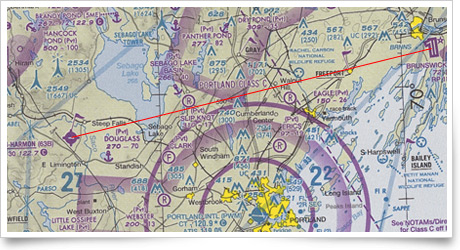| The following stories from the Oct. 21, 2011, edition of AOPA ePilot were provided to AOPA members who expressed an interest in the particular subject areas. Any AOPA member can receive information tailored to their areas of interest by updating their preferences online |
training tipsDrilling down for details Consider the short 33-nautical-mile course discussed in the Oct. 14 “Training Tip: Check in, speak up.” As was noted, a pilot flying a course in Maine from Brunswick Executive Airport to Limington-Harmon Airport would be well advised to contact air traffic control before crossing north of the Class C airspace centered on the Portland International Jetport. Other noteworthy features of the airspace may or may not meet the eye during a casual review. One readily apparent item shows up soon after you depart Brunswick Executive. It’s a symbol on the sectional chart at Freeport, depicting a visual checkpoint just outside the Class C airspace. That’s a clue to stay alert for inbound traffic. Just beyond Freeport, before a set of railroad tracks, is a small national wildlife refuge. Check your altitude; pilots are requested not to overfly these areas below 2,000 feet above the surface. (The chart includes a summary of applicable regulations.) Note the profusion of seaplane bases and private airstrips in the area. One symbol for a private strip has the letter F, not the usual R, in the circle—why? (It is an ultralight flight park.) Obstructions are scattered along the route. If a pilot strayed west and north beyond the destination in marginal weather, obstacles as high as 2,549 feet msl could be encountered west of Sebago Lake. There may be more traffic out there than your chart suggests. If you plan your flight using the AOPA Internet Flight Planner, selecting the option to overlay terminal airspace fixes on the chart, several waypoints will appear. One, called JANOB, lies along your course line. What’s JANOB all about? Your instructor explains that JANOB serves as an initial fix for IFR aircraft flying the RNAV (GPS) approach to Portland’s Runway 18. They cross JANOB at 3,100 feet msl—worth knowing as you fly across the approach course. Waypoints may serve multiple purposes; JANOB also acts as a holding fix for other instrument approaches. Yes, the weather will be fair for your flight. But instrument pilots frequently practice in visual meteorological conditions. So keep your eyes and ears open for opposing traffic. Before you launch, a review of the Air Safety Institute’s Know Before You Go online course will provide a refresher on these and other airspace issues. training productsChart markers from Pilotmall.comWorking on flight planning? Keep sectional charts in good shape with erasable markers that let you draw routes and then remove them. Chart markers come in a package of two (fluorescent yellow and pink) for $2.89. Order online from Pilotmall.com.
Note: Products listed have not been evaluated by ePilot editors unless otherwise noted. AOPA assumes no responsibility for products or services listed or for claims or actions by manufacturers or vendors. final exam
Question: Can a student pilot fly a high-performance airplane during his or her training for a private pilot certificate?
Answer: Yes, a student pilot may fly a high-performance airplane while training for the private pilot certificate. If you choose to use a high-performance airplane your flight instructor will need to provide you with the necessary training specific to high-performance operations and endorse your logbook. When you have the endorsement you will be legal to fly solo as long as your student pilot certificate has all the proper endorsements. Keep in mind that building hours in a high-performance airplane can make it easier to get owners or renters insurance. For more insight, review the Air Safety Institute’s aircraft-specific Safety Highlights.
Got a question for our technical services staff? E-mail [email protected] or call the Pilot Information Center, 800/872-2672. Don’t forget the online archive of “Final Exam” questions and answers, searchable by keyword or topic. |



